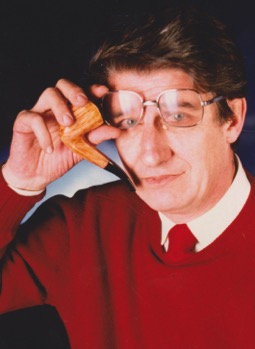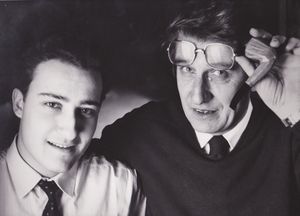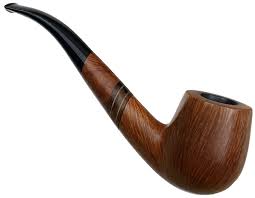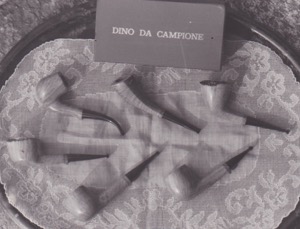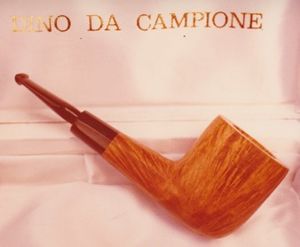Dino da Campione: Difference between revisions
No edit summary |
No edit summary |
||
| Line 1: | Line 1: | ||
'''''See the [[Talk:Dino_da_Campione]] for a more thorough and accurate write up in Italian, which we hope to translate and have here for the main article soon...''''' | '''''See the [[Talk:Dino_da_Campione]] for a more thorough and accurate write up in Italian, which we hope to translate and have here for the main article soon...''''' | ||
[[File:Airaghi Leonardo.jpeg|thumb|left]][[File:DINO E CESARE.jpeg|thumb]][[File:Innesto diagonale.jpeg|thumb|left]][[File:Scan 2.jpeg|thumb]][[File:Scan 3.jpeg|thumb]] | |||
Dino da Campione named Leonardo Airaghi born in Milan (1929 - 2010) was a great interpreter in | |||
pipes of handicrafted manufacture, and considered by many: “ The Chanpion of the Italian | |||
handmade pipe”, the production began in 1969. | |||
Having descended from famous artists, among them: Tomaso Airaghi 1827-1899 and Giovan Battista | |||
Airaghi (1803-1855) and Leonardo Airaghi 1871-1900, Leonardo was provided a wonderful heritage for making pipes with this unique artistic heritage at its foundation. | |||
Each pipe was a carved block, depending on the briar grain; each pipe was born by their own | |||
nature, but always with classic form, elegant and balanced. | |||
Pipes always polished with natural wax, rusticated was wery rare, pipes with briar defects were | |||
abandoned. | |||
Made offen flat surfaces under the pipe and a little foot on the mouthpiece in bone or briarwood to | |||
stand-up the pipe on the table; While maintaining homogeneous the combustion and eliminating | |||
the loss of brace from the stove. Outdoor use was so facilitated. | |||
Maniacal attention to the suction hole to be realized always on the bottom and developing a | |||
particular execution technique. | |||
The customers ordered a: “ Dino da Campione” not a Bulldog or a Billiard. | |||
Just a few small indications were accepted; even when the surprise was great, you fell in love with | |||
the details of your special one “Dino”. | |||
Unlike many craftsmen who, since the mid-1990s, have grown up and developed throughout Italy, | |||
The | Dino da Campione has represented a unicum for "elegance, originality of details and product | ||
quality”. | |||
Presidents of multinationals, nobility and politicians, successful business clients, men of strong | |||
personality and character also sought it at his official workplace (Casino di Campione Manager) to | |||
talk to him and recommend a special one pipe, Which some considered lucky (To the casino!) | |||
From Switzerland he sent to: Florida, Brazil, Venezuela, New York, Delaware, Singapore, Dubai | |||
and Korea. His concern: "the pipe and his endless mouthpiece so far could no longer break ..." to | |||
test the prototypes and eliminate accidental breaks at the clients' homes, toss the pipes against the | |||
laboratory wall often with a negligible result. But finally in the last technical evolution developed | |||
with his son Cesare the mouthpieces and the pipe resisted the test! | |||
Dino was anti-marketing par excellence, so it was the editorialist of: "Friends of the Pipa"; by | |||
making numerous articles always countercurrent and original. | |||
Production was always made up as a hobby by having other activities of family origin, the | |||
commercial dynamics in Italy were almost exclusively owned by Novelli in Rome, which for a long | |||
time remained the only benchmark even with a modest number of pieces available. | |||
Every “Dino” demanded a very important implementation time, here because the production was | |||
limited, but it is a guarantee that each piece punched with the original stamp was made by his | |||
hands. | |||
The punctuation in addition to the "Dino da Campione" mark, could additionally be an “oval” with | |||
the initials "AP" of "Absolutely Perfect" for pipes without the slightest trace of briarwood impurities | |||
and in addition a variable number of up to 4 "Snails" which, like the stars of the hotels, identified | |||
him as a personal ranking. The special denomination: "QUEEN" was reserved for the pieces he | |||
considered extraordinary and of whom he had fallen in love. | |||
The private laboratory still untouched in Switzerland, reveals the details of how many original | |||
solutions have been created: horn ring, silver or gold snail with coral, stand up leg, 5 pieces | |||
unbreakeable mouthpiece, metal ring on topo of the fireplace, etc. | |||
His twentyfive-year collaboration with his son Cesare Airaghi, who in 1980 undertook the career of | |||
designer, even in roots product, has developed the technique of the diagonal anti-breaking | |||
mouthpiece, of which very few specimens are known: pipe and mouthpiece integrate perfectly, | |||
Achieving not only aesthetic momentum but absolute cohesion, making it almost impossible to | |||
break through accidental fall! | |||
These constructive peculiarities, that were absolutely conflicting with the concept of production | |||
standardization; were the opposite of the concept of profit, high in percentage the number of pieces | |||
Dino never wanted to sell and put into his private collection. | |||
Dino continued for his own passion to make pipes until 2005, but after 1999 they were detained by | |||
the family. | |||
Production data per year are the following: | |||
*1969 12 pipes | |||
*1970 24 pipes | |||
*1971 38 pipes | |||
*1972 38 pipes | |||
*1973 60 pipes | |||
*1974 51 pipes | |||
*1975 87 pipes | |||
*1976 27 pipes | |||
*1977 68 pipes | |||
*1978 121 pipes | |||
*1980 92 pipes | |||
*1981 107 pipes | |||
*1982 155 pipes | |||
*1983 187 pipes | |||
*1984 188 pipes | |||
*1985 166 pipes | |||
*1986 201 pipes | |||
*1987 216 pipes | |||
*1988 165 pipes | |||
*1989 177 pipes | |||
*1990 235 pipes | |||
*1991 213 pipes | |||
*1992 188 pipes | |||
*1993 199 pipes | |||
*1994 255 pipes | |||
*1995 237 pipes | |||
*1996 165 pipes | |||
*1997 188 pipes | |||
*1998 176 pipes | |||
*1999 145 pipes | |||
Dino da Campione passed quietly on 10 December 2010 in the family house in Morcote, Switzerland. | |||
[[Category: Pipe makers by nationality]] | [[Category: Pipe makers by nationality]] | ||
[[Category: Italy]] | [[Category: Italy]] | ||
Revision as of 12:04, 18 August 2017
See the Talk:Dino_da_Campione for a more thorough and accurate write up in Italian, which we hope to translate and have here for the main article soon...
Dino da Campione named Leonardo Airaghi born in Milan (1929 - 2010) was a great interpreter in pipes of handicrafted manufacture, and considered by many: “ The Chanpion of the Italian handmade pipe”, the production began in 1969.
Having descended from famous artists, among them: Tomaso Airaghi 1827-1899 and Giovan Battista Airaghi (1803-1855) and Leonardo Airaghi 1871-1900, Leonardo was provided a wonderful heritage for making pipes with this unique artistic heritage at its foundation.
Each pipe was a carved block, depending on the briar grain; each pipe was born by their own nature, but always with classic form, elegant and balanced. Pipes always polished with natural wax, rusticated was wery rare, pipes with briar defects were abandoned.
Made offen flat surfaces under the pipe and a little foot on the mouthpiece in bone or briarwood to stand-up the pipe on the table; While maintaining homogeneous the combustion and eliminating the loss of brace from the stove. Outdoor use was so facilitated. Maniacal attention to the suction hole to be realized always on the bottom and developing a particular execution technique.
The customers ordered a: “ Dino da Campione” not a Bulldog or a Billiard. Just a few small indications were accepted; even when the surprise was great, you fell in love with the details of your special one “Dino”.
Unlike many craftsmen who, since the mid-1990s, have grown up and developed throughout Italy, Dino da Campione has represented a unicum for "elegance, originality of details and product quality”.
Presidents of multinationals, nobility and politicians, successful business clients, men of strong personality and character also sought it at his official workplace (Casino di Campione Manager) to talk to him and recommend a special one pipe, Which some considered lucky (To the casino!) From Switzerland he sent to: Florida, Brazil, Venezuela, New York, Delaware, Singapore, Dubai and Korea. His concern: "the pipe and his endless mouthpiece so far could no longer break ..." to test the prototypes and eliminate accidental breaks at the clients' homes, toss the pipes against the laboratory wall often with a negligible result. But finally in the last technical evolution developed with his son Cesare the mouthpieces and the pipe resisted the test!
Dino was anti-marketing par excellence, so it was the editorialist of: "Friends of the Pipa"; by making numerous articles always countercurrent and original.
Production was always made up as a hobby by having other activities of family origin, the commercial dynamics in Italy were almost exclusively owned by Novelli in Rome, which for a long time remained the only benchmark even with a modest number of pieces available.
Every “Dino” demanded a very important implementation time, here because the production was limited, but it is a guarantee that each piece punched with the original stamp was made by his hands.
The punctuation in addition to the "Dino da Campione" mark, could additionally be an “oval” with the initials "AP" of "Absolutely Perfect" for pipes without the slightest trace of briarwood impurities and in addition a variable number of up to 4 "Snails" which, like the stars of the hotels, identified him as a personal ranking. The special denomination: "QUEEN" was reserved for the pieces he considered extraordinary and of whom he had fallen in love.
The private laboratory still untouched in Switzerland, reveals the details of how many original solutions have been created: horn ring, silver or gold snail with coral, stand up leg, 5 pieces unbreakeable mouthpiece, metal ring on topo of the fireplace, etc.
His twentyfive-year collaboration with his son Cesare Airaghi, who in 1980 undertook the career of designer, even in roots product, has developed the technique of the diagonal anti-breaking mouthpiece, of which very few specimens are known: pipe and mouthpiece integrate perfectly, Achieving not only aesthetic momentum but absolute cohesion, making it almost impossible to break through accidental fall!
These constructive peculiarities, that were absolutely conflicting with the concept of production standardization; were the opposite of the concept of profit, high in percentage the number of pieces Dino never wanted to sell and put into his private collection.
Dino continued for his own passion to make pipes until 2005, but after 1999 they were detained by the family.
Production data per year are the following:
- 1969 12 pipes
- 1970 24 pipes
- 1971 38 pipes
- 1972 38 pipes
- 1973 60 pipes
- 1974 51 pipes
- 1975 87 pipes
- 1976 27 pipes
- 1977 68 pipes
- 1978 121 pipes
- 1980 92 pipes
- 1981 107 pipes
- 1982 155 pipes
- 1983 187 pipes
- 1984 188 pipes
- 1985 166 pipes
- 1986 201 pipes
- 1987 216 pipes
- 1988 165 pipes
- 1989 177 pipes
- 1990 235 pipes
- 1991 213 pipes
- 1992 188 pipes
- 1993 199 pipes
- 1994 255 pipes
- 1995 237 pipes
- 1996 165 pipes
- 1997 188 pipes
- 1998 176 pipes
- 1999 145 pipes
Dino da Campione passed quietly on 10 December 2010 in the family house in Morcote, Switzerland.
